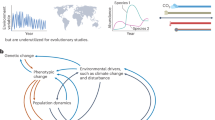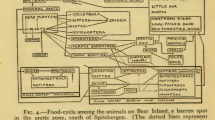Abstract
The term “legacy effect” has been used in ecology since the early 1990s by authors studying plant succession, invasive-plant impacts, herbivory impacts, ecosystem engineering, and human land-use impacts. Although there is some variability in usage, the term is normally used to describe impacts of a species on abiotic or biotic features of ecosystems that persist for a long time after the species has been extirpated or ceased activity and which have an effect on other species. For example, human agricultural activities may have a legacy effect on soil structure and vegetative communities that lasts for centuries and which alters current communities. The concept may be related to the idea of ecological inheritance in evolutionary biology but would refer only to a subset of the features of this concept. In particular, legacy effects could refer to those kinds of ecological inheritance where a physical or biological change in ecosystem state is caused by one species, where this change persists after the extirpation of the causal species and alters selection pressure of another species much later in time.

Similar content being viewed by others
References
Aber JD, Ollinger SV, Dricoll CT (1997) Modeling nitrogen saturation in forest ecosystems in response to land use and atmospheric deposition. Ecol Model 101:61–78
Bassett IE, Simcock RC, Mitchell ND (2005) Consequences of soil compaction for seedling establishment: implications for natural regeneration and restoration. Austral Ecol 30:827–833
Bowman DMJS, Prior LD, de Little SC (2010) Retreating Melaleuca swamp forests in Kakadu National Park: evidence of synergistic effects of climate change and past feral buffalo impacts. Austral Ecol 35:898–905
Carson WP, Banta JA, Royo AA, Kirschbaum C (2005) Plant communities growing on boulders in the Allegheny National Forest: evidence for boulders as refugia from deer and as a bioassay of overbrowsing. Nat Area J 25:10–18
Clements F (1916) Plant succession. Publication 242. Carnegie Institute of Washington, Washington, DC
Davis MA, Pelsor M (2001) Experimental support for a resource-based mechanistic model of invasiblity. Ecol Lett 4:421–428
Davis MA, Bier L, Bushelle E, Diegel C, Johnson A, Kujala B (2005) Non-indigenous grasses impede woody succession. Plant Ecol 178:249–264
Densmore RV (2005) Succession on subalpine placer mine spoil: effects of revegetation with Alnus viridis, Alaska, USA. Arct Antarct Alp Res 37:297–303
Elgersma KJ, Ehrenfeld JG, Yu S, Vor T (2011) Legacy effects overwhelm the short-term effects of exotic plant invasion and restoration on soil microbial community structure, enzyme activities, and nitrogen cycling. Oecologia 167:733–745
Estes JA, Terborgh J, Brashares JS, Power ME, Berger J et al (2011) Trophic downgrading of planet Earth. Science 333:301–306
Flinn KM, Vellend M (2005) Recovery of forest plant communities in post-agricultural landscapes. Front Ecol Environ 3:243–250
Foster D, Swanson F, Aber J, Burke I, Brokaw N, Tilman D, Knapp A (2003) The importance of land-use legacies to ecology and conservation. Bioscience 53:77–88
Gleason HA (1917) The structure and development of plant association. Bull Torrey Bot Club 53:7–26
Grman E, Suding KN (2010) Within-year soil legacies contribute to strong priority effects of exotics on native California grassland communities. Restor Ecol 18:664–670
Harding JS, Benfield EF, Bolstad PV, Helfman GS, Jones EBD III (1998) Stream biodiversity: the ghost of land use past. Proc Nat Acad Sci 95:14843–14847
Hastings A, Byers JE, Crooks JA, Cuddington K, Jones CG, Lambrinos JG, Talley TS, Wilson WG (2007) Ecosystem engineering in space and time. Ecol Lett 10:153–164
Heneghan L, Fatemi F, Umek L, Grady K, Fagen K, Workman M (2006) The invasive shrub European buckthorn (Rhamnus cathartica, L.) alters soil properties in midwestern U.S. woodlands. Appl Soil Ecol 32:142–148
Huntzinger M, Karban R, Maron JL (2011) Small mammals cause non-trophic effects on habitat and associated snails in a native system. Oecologia 167:1085–1091
Jordan NR, Larson DL, Huerd SC (2011) Evidence of qualitative differences between soil-occupancy effects of invasive vs. native grassland plant species. Invas Plant Sci Manage 4:11–21
Kardol P, Cornips NJ, van Kempen MML, Bakx-Schotman JMT, van der Pitten WH (2007) Microbe-mediated plant-soil feedback causes historical contingency effects in plant community assembly. Ecol Monogr 77:147–162
Kourtev PS, Ehrenfeld JG, Haggblom M (2002) Exotic plant species alter the microbial community structure and function in the soil. Ecology 83:3152–3166
Laland KN, Odling-Smee FJ, Feldman MW (1996) The evolutionary consequences of niche construction. J Evol Biol 9:293–316
Laland KN, Odling-Smee FJ, Feldman MW (1999) Evolutionary consequences of niche construction and their implications for ecology. Proc Nat Acad Sci 96:10242–10247
Lehmann L (2007) The evolution of trans-generational altruism: kin selection meets niche construction. J Evol Biol 20:181–189
Lehmann L (2008) The adaptive dynamics of niche constructing traits in spatially subdivided populations: evolving posthumous extended phenotypes. Evolution 62:549–566
Lett MS, Knapp AK (2005) Woody plant encroachment and removal in mesic grassland: production and composition responses of herbaceous vegetation. Am Midl Nat 153:217–231
Mack MC, D’Antonio CM (2003) Exotic grasses alter controls over soil nitrogen dynamics in a Hawaiian woodland. Ecol Appl 13:154–166
Martin SL, Hayes DB, Rutledge DT, Hyndman DW (2011) The land-use legacy effect: adding temporal context to lake chemistry. Limnol Oceanogr 56:2363–2370
McLauchlan K (2006) The nature and longevity of agricultural impacts on soil carbon and nutrients: a review. Ecosystems 9:1364–1382
Molina R, Amaranthus M (1991) Rhizosphere biology: ecological linkages between soil processes, plant growth, and community dynamics. US Department of Agriculture, Forest Service Intermountain Research Station, General Technical Report 280
Mullineaux LS, Micheli F, Peterson CH, Lenihan HS, Markus N (2009) Imprint of past environmental regimes on structure and succession of a deep-sea hydrothermal vent community. Oecologia 161:387–400
Nuttle T, Yerger EH, Stoleson SH, Ristau TE (2011) Legacy of top-down herbivore pressure ricochets back up multiple trophic levels in forest canopies over 30 years. Ecosphere 2(1):Article 4
Odling-Smee FJ, Laland KN (2012) Ecological inheritance and cultural inheritance: what are they and how do they differ? Biol Theory 6. doi:10.1007/s13752-012-0030-x
Olding-Smee FJ (1988) Niche-constructing phenotypes. In: Plotkin H (ed) The role of behavior in evolution. MIT Press, Cambridge, pp 73–132
Orr SP, Rudgers JA, Clay K (2005) Invasive plants can inhibit native tree seedlings: testing potential allelopathic mechanisms. Plant Ecol 181:153–165
Perry DA (1994) Forest ecosystems. John Hopkins University Press, Baltimore
Perry DA, Oren R, Hart SC (2008) Forest ecosystems, 2nd edn. John Hopkins University Press, Baltimore
Pregitzer C, Bailey J, Hart S, Schweitzer J (2010) Soils as agents of selection: feedbacks between plants and soils alter seedling survival and performance. Evol Ecol 24:1045–1059
Sharrow SH (2007) Soil compaction by grazing livestock in silvopastures as evidenced by changes in soil physical properties. Agroforest Sys 71:215–223
Simard SW (1995) Interspecific carbon transfer in ectomycorrhizal tree species mixtures. PhD dissertation, Department of Forest Science, Oregon State University, Corvallis
van de Voorde TFJ, van der Putten WH, Bezemer TM (2011) Intra- and interspecific plant–soil interactions, soil legacies and priority effects during old-field succession. J Ecol 99:945–953
Wang B, Qiu Y-L (2006) Phylogenetic distribution and evolution of mycorrhizas in land plants. Mycorrhiza 16:299–363
Author information
Authors and Affiliations
Corresponding author
Rights and permissions
About this article
Cite this article
Cuddington, K. Legacy Effects: The Persistent Impact of Ecological Interactions. Biol Theory 6, 203–210 (2011). https://doi.org/10.1007/s13752-012-0027-5
Received:
Accepted:
Published:
Issue Date:
DOI: https://doi.org/10.1007/s13752-012-0027-5




